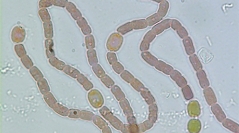

 Cryptogamie, Algologie
44 (3) - Pages 59-84
Cryptogamie, Algologie
44 (3) - Pages 59-84Cyanobacteria are a lineage of Eubacteria that have long captured the attention of scientists. Approximately 5310 species of cyanobacteria have been hitherto described and new species are continually being found, named and described according to established rules. The correct determination of cyanobacteria strains concerns new biotechnological applications as well as ecological studies. There are many situations where it is crucial to recognise distinct algae species, however methods for doing so vary greatly. The aim of this review is to summarize the state of the art of the main and most recent molecular studies focusing on the phylum Cyanobacteria, with particular attention to the most frequently used gene markers. For a long time, the classification method used for cyanobacteria as well as traditionally described species was mainly based on morphology. Over time, integrative taxonomy, which involves the inclusion of many characters and comprehensive taxa sampling, has become the rule as it provides a better resolution of species relationships. For a better resolution of the phylogenies of the phylum Cyanobacteria, it is usually necessary to focus on different genetic markers: from the most common, like the 16S and 23S rRNA, ITS, rbcLXS and rpoC genes, to genes not so widely used, such as hetR, psbA, tufA, gyp and cpcBA. Also, the highly repetitive sequences often used for the symbiotic cyanobacteria represent an important factor in the inference of the phylogenetic relationships.
Cyanobacteria, functional genes, structural genes, highly repetitive sequences, phylogeny